鲁教版六年级英语知识点总结共86页
鲁教版英语六年级下册期末常考知识点汇总

六年级下册期末常考知识点汇总1.--when is +主语+birthday?某人的生日什么时候?when疑问副词,引导提殊疑问句,其结构为“when+一般疑问句?”when可以对年、月、日以及时刻进行提问或者询问某一动作发生的时间。
--It 's+月+日,+年。
是...年...月...日.When is your birthday?My birthday is on May 2nd./It is on May 2nd2.—how old +be+主语?...多大年纪/几岁了?How old 意为“多大年纪;几岁”,用来询问年龄。
答语常用--主语+be+基数词+years/months old. ......岁3.want to do sth. 想要做某事4.happy birthday生日快乐,其答语为:thank you./thanks a lot./thank you very much.5.一年十二个月份,月份前常用介词in。
Month的复数是months。
6.do you want to come to my birthday party?(第2页)7.be busy doing sth.=be busy with sth.忙于(做)某事。
She is busy doing her homework.=She is busy with her homework.她正忙着做家庭作业。
8. When is Ailce's birthday?(第2页)艾丽斯的生日是什么时候?解析:Ailce's为名词所有格形式,意为“艾丽斯的”。
名词所有格表示人或物的所有和所属关系,在句中作定语名词所有格的构成有's所有格、of所有格和双重所有格三种形式。
1)'s所有格的构成。
一般情况下在单数名词的词尾加's。
Jim's book以-s 或-es结尾的复数名词,在词尾加“'”。
鲁教版英语六年级下册期末常考知识点汇总
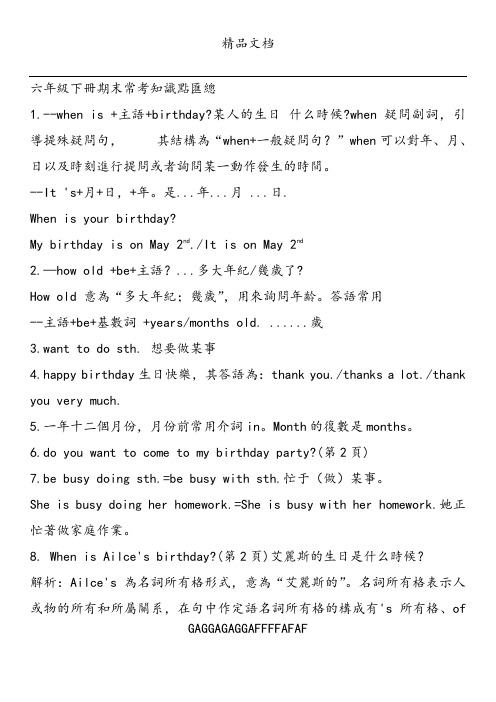
六年級下冊期末常考知識點匯總1.--when is +主語+birthday?某人的生日什么時候?when疑問副詞,引導提殊疑問句,其結構為“when+一般疑問句?”when可以對年、月、日以及時刻進行提問或者詢問某一動作發生的時間。
--It 's+月+日,+年。
是...年...月 ...日.When is your birthday?My birthday is on May 2nd./It is on May 2nd2.—how old +be+主語?...多大年紀/幾歲了?How old 意為“多大年紀;幾歲”,用來詢問年齡。
答語常用--主語+be+基數詞 +years/months old. ......歲3.want to do sth. 想要做某事4.happy birthday生日快樂,其答語為:thank you./thanks a lot./thank you very much.5.一年十二個月份,月份前常用介詞in。
Month的復數是months。
6.do you want to come to my birthday party?(第2頁)7.be busy doing sth.=be busy with sth.忙于(做)某事。
She is busy doing her homework.=She is busy with her homework.她正忙著做家庭作業。
8. When is Ailce's birthday?(第2頁)艾麗斯的生日是什么時候?解析:Ailce's為名詞所有格形式,意為“艾麗斯的”。
名詞所有格表示人或物的所有和所屬關系,在句中作定語名詞所有格的構成有's所有格、ofGAGGAGAGGAFFFFAFAF所有格和雙重所有格三種形式。
1)'s所有格的構成。
一般情況下在單數名詞的詞尾加's。
Jim's book以-s 或-es結尾的復數名詞,在詞尾加“'”。
鲁教版英语六年级下册期末常考知识点汇总
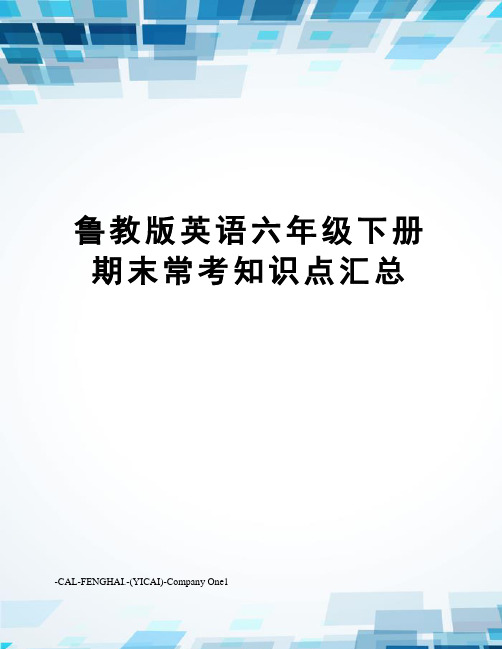
鲁教版英语六年级下册期末常考知识点汇总-CAL-FENGHAI.-(YICAI)-Company One1六年级下册期末常考知识点汇总1.--when is +主语+birthday?某人的生日什么时候when疑问副词,引导提殊疑问句,其结构为“when+一般疑问句”when可以对年、月、日以及时刻进行提问或者询问某一动作发生的时间。
--It 's+月+日,+年。
是...年...月 ...日.When is your birthday?My birthday is on May 2nd./It is on May 2nd2.—how old +be+主语?...多大年纪/几岁了How old 意为“多大年纪;几岁”,用来询问年龄。
答语常用--主语+be+基数词 +years/months old. ......岁3.want to do sth. 想要做某事4.happy birthday生日快乐,其答语为:thank you./thanks a lot./thank you very much.5.一年十二个月份,月份前常用介词in。
Month的复数是months。
6.do you want to come to my birthday party(第2页)7.be busy doing sth.=be busy with sth.忙于(做)某事。
She is busy doing her homework.=She is busy with her homework.她正忙着做家庭作业。
8. When is Ailce's birthday(第2页)艾丽斯的生日是什么时候?解析:Ailce's为名词所有格形式,意为“艾丽斯的”。
名词所有格表示人或物的所有和所属关系,在句中作定语名词所有格的构成有's所有格、of所有格和双重所有格三种形式。
1)'s所有格的构成。
鲁教版六年级上册英语全册重点

鲁教版六年级上册英语全册重点2.What color is it?它是什么颜色的?It’s +颜色。
It’s blue.它是蓝色的。
3.red红色yellow黄色green绿色blue蓝色purple紫色pink粉红色black黑色white白色brown棕色orange橙色4.How do you spell it?你怎么拼写它?Spell it。
please.请拼写它。
5.crayon蜡笔markerXXX铅笔XXX钢笔eraser橡皮擦ruler直尺In this unit。
we learn about colors and how to describe objects using colors。
We also learn how to spell words and ask for spellings。
Some common colors include red。
yellow。
green。
blue。
purple。
pink。
black。
white。
brown。
and orange。
To ask for the spelling of a word。
we can say “How do you spell it?” or “Spell it。
please.” Some common nery items include crayons。
markers。
pencils。
pens。
erasers。
and rulers.1) What is this/that。
What is this/that thing?2) It's a ruler。
It's an apple.3) What color is the key。
It's yellow。
What color are the keys。
They're red.4) It's black and white.5) S is small。
鲁教版(五四制)六年级英语上册Unit2重难点知识点归纳
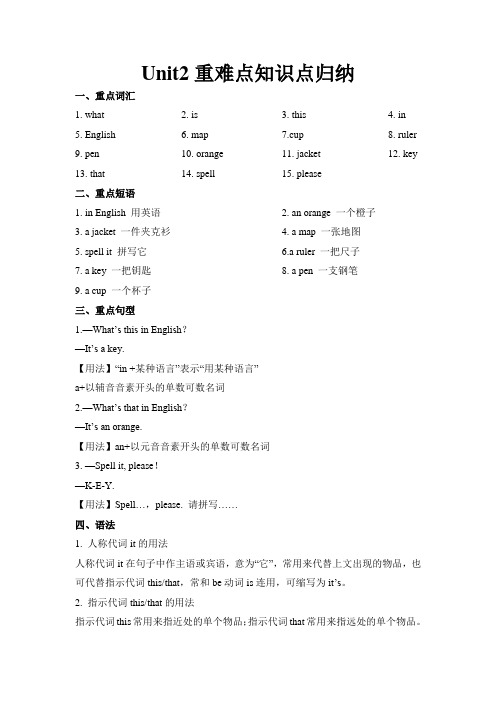
Unit2重难点知识点归纳一、重点词汇1. what2. is3. this4. in5. English6. map7.cup8. ruler9. pen 10. orange 11. jacket 12. key13. that 14. spell 15. please二、重点短语1. in English 用英语2. an orange 一个橙子3. a jacket 一件夹克衫4. a map 一张地图5. spell it 拼写它6.a ruler 一把尺子7. a key 一把钥匙8. a pen 一支钢笔9. a cup 一个杯子三、重点句型1.—What’s this in English?—It’s a key.【用法】“in +某种语言”表示“用某种语言”a+以辅音音素开头的单数可数名词2.—What’s that in English?—It’s an orange.【用法】an+以元音音素开头的单数可数名词3. —Spell it, please!—K-E-Y.【用法】Spell…,please. 请拼写……四、语法1. 人称代词it的用法人称代词it在句子中作主语或宾语,意为“它”,常用来代替上文出现的物品,也可代替指示代词this/that,常和be动词is连用,可缩写为it’s。
2. 指示代词this/that的用法指示代词this常用来指近处的单个物品;指示代词that常用来指远处的单个物品。
3. 不定冠词a/an的用法冠词是置于名词之前,说明名词所表示的人或事物的一种虚词。
不定冠词常表示“一”的概念,有两种形式:a和an。
a用在以辅音音素开头的名词前,an用在以元音音素开头的名词前。
特殊情况:(1)元音字母u的读音以辅音音素开头,因此“一个u”应表达为“a u”。
(2)以元音字母开头的词以辅音音素开头,其前面用a。
如:a useful book 一本有用的书a uniform 一套制服a European country 一个欧洲国家(3)以辅音字母开头的词,辅音字母不发音,而以元音音素开头,其前面用an。
六年级英语鲁教版上Unit1-Unit6知识点,学霸必备!
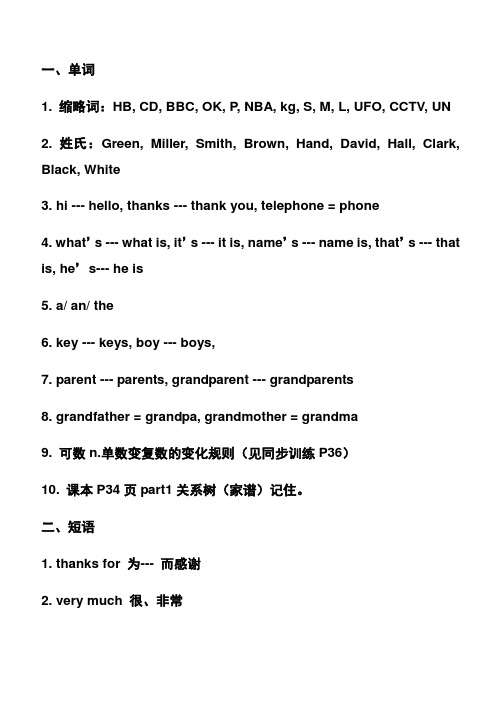
一、单词1. 缩略词:HB, CD, BBC, OK, P, NBA, kg, S, M, L, UFO, CCTV, UN2. 姓氏:Green, Miller, Smith, Brown, Hand, David, Hall, Clark, Black, White3. hi --- hello, thanks --- thank you, telephone = phone4. what’s --- what is, it’s --- it is, name’s --- name is, that’s --- that is, he’s--- he is5. a/ an/ the6. key --- keys, boy --- boys,7. parent --- parents, grandparent --- grandparents8. grandfather = grandpa, grandmother = grandma9. 可数n.单数变复数的变化规则(见同步训练P36)10. 课本P34页part1关系树(家谱)记住。
二、短语1. thanks for 为--- 而感谢2. very much 很、非常3. pen friend 笔友4. family photo 全家福5. a photo of --- --- 的照片6. pencil sharpener 铅笔刀7. excuse me 打扰一下,请原谅8. lost and found 失物招领9. a set of--- 一套、一副、一串---10. in the lost and found case 在失物招领柜里(Lost and Found Office 失物招领处)11. in English 用英语表达12. call sb. at --- 给某人打电话--- eg: Please call Tom at 7654321.13. first name 名,family name = last name 姓14. telephone(phone) number 电话号码15. ID card 身份证16. what color 什么颜色,black and white 黑白色17. a map of China = a Chinese map 一幅中国地图三、句型1. This (that) is his father/ These (Those) are his parents.2. --- Is this/ that Jim? --- Yes, it is/ No, it isn’t.3. --- Is this/ that her brother? --- Yes, it is/ No, it isn’t.4. --- Are these/ those his sisters? --- Yes, they are/ No, they aren’t.5. --- Is he/ she your uncle/ aunt? --- Yes, he(she) is/ No, he(she) isn’t.6. --- Are they her grandparents? --- Yes, they are/ No, they aren’t.7. --- Is Mary his mother? --- Yes, she is/ No, she isn’t.8. --- Are Tony and Jack your friends? --- Yes, they are/ No, they aren’t.9. Thanks for the photo of your family. 谢谢你的家庭照。
鲁教版(五四制)六年级英语下册各单元重点知识汇总
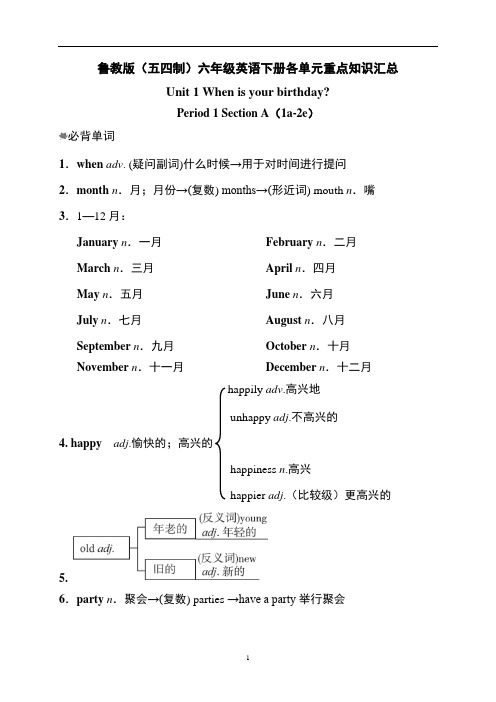
鲁教版(五四制)六年级英语下册各单元重点知识汇总Unit 1 When is your birthday?Period 1 Section A(1a-2e)必背单词1.when adv. (疑问副词)什么时候→用于对时间进行提问2.month n.月;月份→(复数) months→(形近词) mouth n.嘴3.1—12月:January n.一月February n.二月March n.三月April n.四月May n.五月June n.六月July n.七月August n.八月September n.九月October n.十月November n.十一月December n.十二月happily adv.高兴地unhappy adj.不高兴的4.happy adj.愉快的;高兴的happiness n.高兴happier adj.(比较级)更高兴的5.6.party n.聚会→(复数) parties →have a party举行聚会必背短语7.Alice's birthday艾丽斯的生日8.your father's birthday 你父亲的生日9.in August 在八月10.at three this afternoon今天下午三点钟必背句子11.—When is your birthday,Mike?迈克,你的生日是什么时候?—My birthday is on June 3rd.我的生日是在六月三日。
12.Happy birthday! 生日快乐!13.—How old are you? 你多大了?—I'm thirteen. 我十三岁了。
14. Well,do you want to come to my birthday party?哦,你想来参加我的生日聚会吗?15.—When is it? 聚会是在什么时候?—At three this afternoon. 今天下午三点钟。
鲁教版六年级下册英语知识点总结
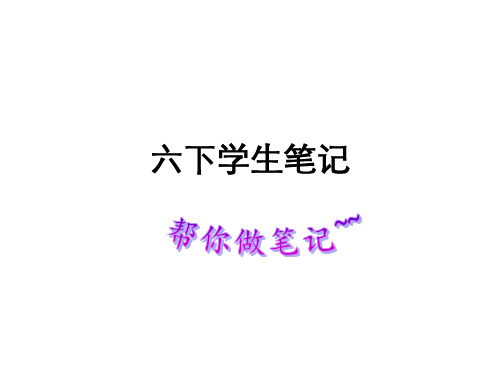
Unit2 重点短语
15.after that 在那之后
Unit2 重点句型
1.-What’s your favorite subject?你最喜欢的 科目是什么?=What subject do you like best? -My favorite subject is science. 我最喜欢的 科目是科学。=I like science best. 2.Her favorite fruit is strawberries.= She likes strawberries best.她最喜欢的水果是 草莓。 3.His favorite day is Sunday.= He likes Sunday best. 他最喜欢星期天。
Unit2 重点句型
11.-What day is it today? -It’s Friday. 12.What date is it today? It’s September 10th. 今天几号? 今天是9月10日。 13.The teacher says it is useful, but I think it is difficult. 老师说它有用,但我认为它很难。 14.It is a useful book. 这是一本有用的书。 15.Lunch is from 12:00 to 1:00. 午餐是12点到1点。
1.-When is your birthday? -My birthday is on May 2nd. 2.-When is your father’s birthday? -His birthday is on April 21st. 3.-Happy birthday! –Thank you, Bill. 4.-How old are you?=What’s your age? -I’m thirteen (years old).
最新鲁教版六年级下册英语 全册重点
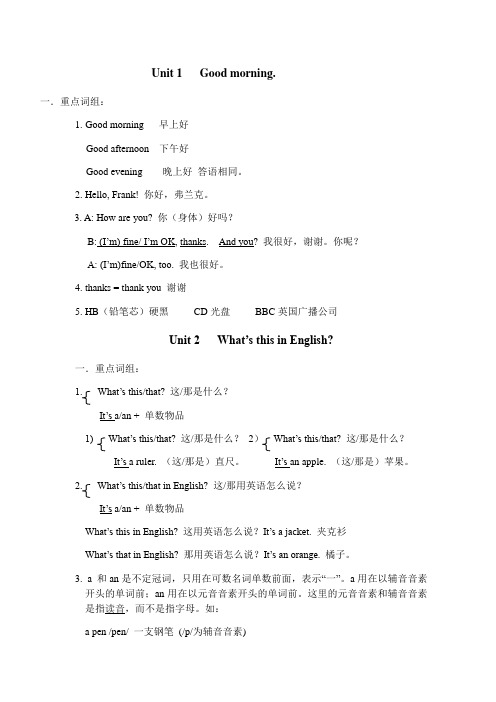
Unit 1 Good morning.一.重点词组:1.Good morning 早上好Good afternoon 下午好Good evening 晚上好答语相同。
2. Hello, Frank! 你好,弗兰克。
3. A: How are you? 你(身体)好吗?B: (I’m) fine/I’m OK, thanks. And you? 我很好,谢谢。
你呢?A: (I’m)fine/OK, to o. 我也很好。
4. thanks = thank you 谢谢5. HB(铅笔芯)硬黑CD光盘BBC英国广播公司Unit 2 What’s this in English?一.重点词组:1. What’s this/that? 这/那是什么?It’s a/an + 单数物品1) What’s this/that? 这/那是什么?2)What’s this/that? 这/那是什么?It’s a ruler. (这/那是)直尺。
It’s an apple. (这/那是)苹果。
2. What’s this/that in English? 这/那用英语怎么说?It’s a/an + 单数物品What’s this in English? 这用英语怎么说?It’s a jacket. 夹克衫What’s that in English? 那用英语怎么说?It’s an orange. 橘子。
3. a 和an是不定冠词,只用在可数名词单数前面,表示“一”。
a用在以辅音音素开头的单词前;an用在以元音音素开头的单词前。
这里的元音音素和辅音音素是指读音,而不是指字母。
如:a pen /pen/ 一支钢笔(/p/为辅音音素)an orange /’ ɒrindʒ / 一个桔子(/ɒ /为元音音素)4. P停车场;停车位NBA(美国)全国篮球协会kg千克;公斤5. Spell it, please. = Please spell it. 请拼读它。
鲁教版英语六年级下册期末常考知识点汇总
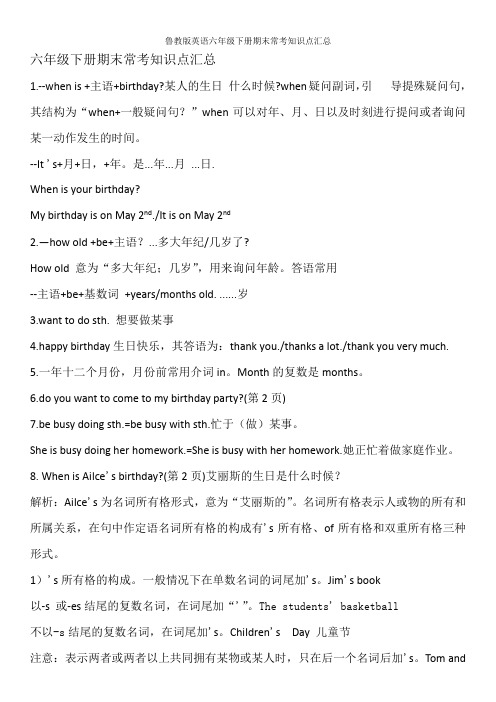
六年级下册期末常考知识点汇总1.--when is +主语+birthday?某人的生日什么时候?when疑问副词,引导提殊疑问句,其结构为“when+一般疑问句?”when可以对年、月、日以及时刻进行提问或者询问某一动作发生的时间。
--It 's+月+日,+年。
是...年...月...日.When is your birthday?My birthday is on May 2nd./It is on May 2nd2.—how old +be+主语?...多大年纪/几岁了?How old 意为“多大年纪;几岁”,用来询问年龄。
答语常用--主语+be+基数词+years/months old. ......岁3.want to do sth. 想要做某事4.happy birthday生日快乐,其答语为:thank you./thanks a lot./thank you very much.5.一年十二个月份,月份前常用介词in。
Month的复数是months。
6.do you want to come to my birthday party?(第2页)7.be busy doing sth.=be busy with sth.忙于(做)某事。
She is busy doing her homework.=She is busy with her homework.她正忙着做家庭作业。
8. When is Ailce's birthday?(第2页)艾丽斯的生日是什么时候?解析:Ailce's为名词所有格形式,意为“艾丽斯的”。
名词所有格表示人或物的所有和所属关系,在句中作定语名词所有格的构成有's所有格、of所有格和双重所有格三种形式。
1)'s所有格的构成。
一般情况下在单数名词的词尾加's。
Jim's book以-s 或-es结尾的复数名词,在词尾加“'”。
鲁教版六年级下册英语全册知识点整理
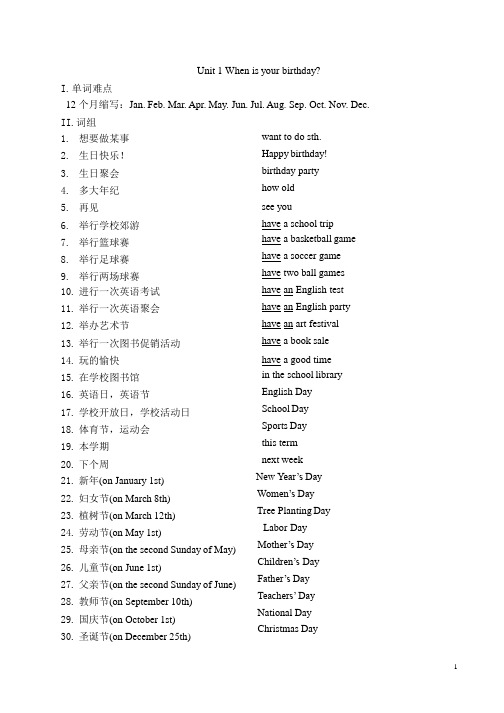
English Day
17. 学校开放日,学校活动日
School Day
18. 体育节,运动会 19. 本学期 20. 下个周 21. 新年(on January 1st) 22. 妇女节(on March 8th) 23. 植树节(on March 12th) 24. 劳动节(on May 1st) 25. 母亲节(on the second Sunday of May) 26. 儿童节(on June 1st) 27. 父亲节(on the second Sunday of June) 28. 教师节(on September 10th) 29. 国庆节(on October 1st) 30. 圣诞节(on December 25th)
3. 生日聚会
birthday party
4. 多大年纪
how old
5. 再见
see you
6. 举行学校郊游
have a school trip
7. 举行篮球赛 8. 举行足球赛 9. 举行两场球赛 10. 进行一次英语考试
have a basketball game have a soccer game have two ball games have an English test
24. 对某人严格要求
be strict with sb.
25. 对某事严格要求
be strict in sth.
II. Sentences (句子) (P9 Grammar Focus)
1. 让我们周六见吧。
Let’s meet on Saturday.
2. 今天星期几?
What day is it today?
Unit 1 When is your birthday?
鲁教版五四制英语六年级上册Unit8 知识点汇总
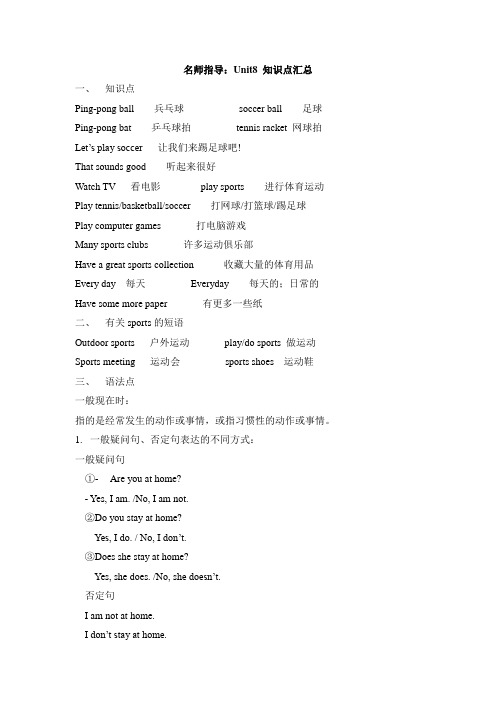
名师指导:Unit8 知识点汇总一、知识点Ping-pong ball 兵乓球soccer ball 足球Ping-pong bat 乒乓球拍tennis racket 网球拍Let’s play soccer 让我们来踢足球吧!That sounds good 听起来很好Watch TV 看电影play sports 进行体育运动Play tennis/basketball/soccer 打网球/打篮球/踢足球Play computer games 打电脑游戏Many sports clubs 许多运动俱乐部Have a great sports collection 收藏大量的体育用品Every day 每天Everyday 每天的;日常的Have some more paper 有更多一些纸二、有关sports的短语Outdoor sports 户外运动play/do sports 做运动Sports meeting 运动会sports shoes 运动鞋三、语法点一般现在时:指的是经常发生的动作或事情,或指习惯性的动作或事情。
1.一般疑问句、否定句表达的不同方式:一般疑问句①- Are you at home?- Yes, I am. /No, I am not.②Do you stay at home?Yes, I do. / No, I don’t.③Does she stay at home?Yes, she does. /No, s he doesn’t.否定句I am not at home.I don’t stay at home.She doesn’t stay at home.3. 主语为第三人称单数时,谓语行为动词的变化。
She plays computer games on Sundays.She studies English every morning.She goes to school on weekdays.She has breakfast at 6:45.4. 用法:(1) 表示现在的状况:I am a teacher. You are student. They are in London.(2) 表示经常的或习惯性的动作:I usually go to school on foot. She plays tennis every morning.(3) 表示主语具备的性格和能力等:He likes playing basketball. They do the cooking.。
鲁教版英语六年级上册重点句型归纳
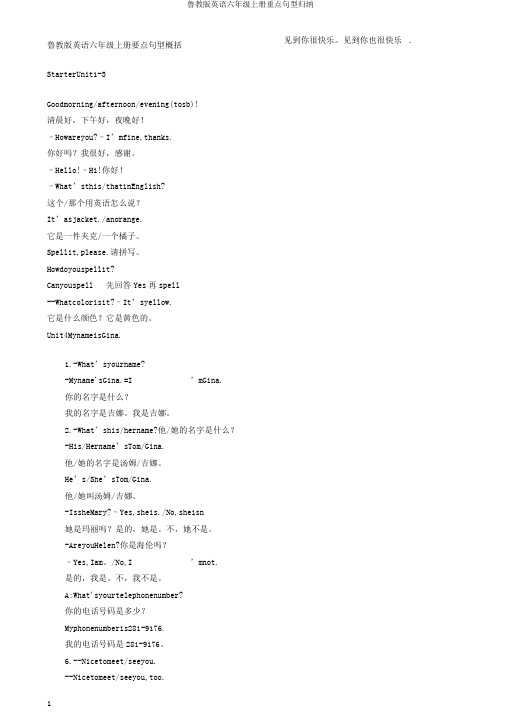
见到你很快乐。
见到你也很快乐.鲁教版英语六年级上册要点句型概括StarterUnit1-3Goodmorning/afternoon/evening(tosb)!清晨好,下午好,夜晚好!–Howareyou?–I’mfine,thanks.你好吗?我很好,感谢。
–Hello!–Hi!你好!–What’sthis/thatinEnglish?这个/那个用英语怎么说?It’asjacket./anorange.它是一件夹克/一个橘子。
Spellit,please.请拼写。
Howdoyouspellit?Canyouspell 先回答Yes再spell--Whatcolorisit?–It’syellow.它是什么颜色?它是黄色的。
Unit4MynameisGina.1.-What’syourname?-Myname'sGina.=I ’mGina.你的名字是什么?我的名字是吉娜。
我是吉娜。
2.-What’shis/hername?他/她的名字是什么?-His/Hername’sTom/Gina.他/她的名字是汤姆/吉娜。
He’s/She’sTom/Gina.他/她叫汤姆/吉娜。
-IssheMary?–Yes,sheis./No,sheisn她是玛丽吗?是的,她是。
不,她不是。
-AreyouHelen?你是海伦吗?–Yes,Iam。
/No,I ’mnot.是的,我是。
不,我不是。
A:What'syourtelephonenumber?你的电话号码是多少?Myphonenumberis281-9176.我的电话号码是281-9176。
6.--Nicetomeet/seeyou.--Nicetomeet/seeyou,too.7.You’re welcome.不用谢。
stname=familynamelastname姓氏firstname=givenname名字8.telephonenumber=phonenumber电话号码Unit5Thisismysister.This/ThatismyfriendJane.这是/那是我的朋友简。
最新鲁教版英语六年级下册期末常考知识点汇总

最新鲁教版英语六年级下册期末常考知识点汇总2.—how old +be+主语?...多大年纪/几岁了?How old 意为“多大年纪;几岁”,用来询问年龄.答语常用--主语+be+基数词+years/months old. ......岁3.want to do sth. 想要做某事5.一年十二个月份,月份前常用介词in.Month的复数是months.6.do第2页)7.be busy doing sth.=be busy with sth.忙于(做)某事.She is busy doing her homework.=She is busy with her homework.她正忙着做家庭作业.8. When is Ailce's birthday?(第2页)艾丽斯的生日是什么时候?解析:Ailce's为名词所有格形式,意为“艾丽斯的”.名词所有格表示人或物的所有和所属关系,在句中作定语名词所有格的构成有's所有格、of所有格和双重所有格三种形式.1)'s所有格的构成.一般情况下在单数名词的词尾加's.Jim's book以-s 或-es结尾的复数名词,在词尾加“'”.The students' basketball不以-s结尾的复数名词,在词尾加's.Children's Day 儿童节注意:表示两者或两者以上共同拥有某物或某人时,只在后一个名词后加's.Tom and Jim's teacher 汤姆和吉姆的老师表示两人各自拥有不同的人或物时,两个名词都要加's ,Lucy's and Licy's brothers. 露西的哥哥和莉莉的哥哥2)of 所有格的构成名词+of +名词便构成of 所有格.a picture of my family3)双重所有格把of所有格和's所有格结合在一起表示所有关系的结构就构成了名词的双重所有格. a friend of my father's, a daught of Mr.Green's9.You第5页)Can 情态动词,“能;会”,表示说话人的情感、态度和能力.不能单独作谓语,只能和实义动词一起构成谓语,且没有人称和数的变化,其后的动词要用原形.含有情态动词的句子在变一般疑问句时,要把情态动词提前;变否定句时,在情态动词后加not.Can you see the ball under the chair?I can't see the ball.第二单元2.Because it's fun.(第8页)解析:1)because,连词“因为”,后面跟从句,陈述原因或理由,回答why提出的问句.--Why isn't Li Ping here? --Because she is ill.2)注意:because引导原因状语从句,在汉语中,我们常说因为....所以...,但是在英语中,因为和所以只能用其一.即在同一个句子中,because和so不能同时使用,用because就不能用so,用so 就不能用because.3)have fun doing ...,表示“做...很愉快”We have fun learning English.3. I am very busy on Friday.(第11页)解析,on Friday,“在星期五”.On 常表示在星期几或具体某一日或某一日的上午、下午、或晚上的名词前.年月周前要用in;具体时间点之前用at.只说上午、下午、晚上用in.4.from...to...,从...到...,既可指时间,又可指空间.5. finish ,作及物动词,后接动词时,要用动名词,即:finish doing sth.第三单元1 play chess 下国际象棋(教材第13页)play 玩,演奏.play+表示球类或棋类的名词,表示“参加(体育比赛或游戏)”,球类棋类名词前不用任何冠词.如play football,play basketball,play cardsplay the guitar 弹吉他.Play+表示乐器的名词,表示“吹奏、弹奏某种乐器”,乐器名词前要加定冠词the.如play the violin ,play the piano巧记play的用法:打球玩牌下象棋,其后不能把the 加;若把乐器来演奏,定冠词the 必须跟;与人比赛或扮演,动词play它都管.第三单元4.What club do you want to join?你想加入什么俱乐部?句型分析:本句是what 引导的特殊疑问句,what是特殊疑问词,它既可以单独使用,对事物进行提问,也可以和名词或名词短语共同构成一个特殊疑问词短语,放在句首,构成特殊疑问句.如:What color do you like? What class are you in ?注意:特殊疑问句是对句中的某一成分进行提问,句首用疑问词,句末用问号,一般用降调朗读.5. What about you?你呢?(教材第14页)What abot...?意为“......怎么样”与How about...?同义,常用于询问消息、征求意见或建议,其中about为介词,后接名词、代词或动词的-ing形式.如:I want to walk to school.What/How about you?6. You're very good at telling stories.你非常擅长讲故事.(教材第14页) 1)be good at 意为“擅长”,相当于do well in,后可接名词、代词或动词的-ing形式. I'm good at English.He is good at drawing.=He does well in drawing.2)tell的常用结构:tell后常跟双宾语,即tell sb.sth.(=tell sth. to sb.)意为“告诉某人某事”.tell sb.(not)to do sth. 告诉某人(不要)做某事7 Sounds good听起来不错.(教材第14页)sound作连系动词,意为“听起来”,常接形容词作表语.常用sound like ...后常接名词.That sounds like a good idea.同类归纳:可接形容词的感官动词:look,smell,feel,taste等都是连系动词,与sound 用法相同,其后均可接形容词作表语,意思分别为“看/闻/摸/尝”;look/smell/feel/taste like,意为“看/闻/摸/尝起来像......”9.Are you good with old people?你善于与老人相处吗?(教材第17页)be good with...善于应付......,对......有办法,相当于get on well with. She is good with her friends.=She gets on well with her friends.他与朋友们相处得好.拓展:与good有关的短语:be good at 擅长 David is good at swimming.be good to...对......好 Be good to him,OK?be good for ...对......有益Milk is good for our health.10.They can tell you stories and you can make friends.(教材17页)他们可以给你讲故事,你们可以交朋友.make friends 意为“交朋友”,表示“和......交朋友”,用make friends with sb. I want to make friends with you.11. Then we need you to help with sports for English-speaking students.(教材第17页)要你帮助说英语的学生开展体育运动.1)help (sb.)with sth.在某方面帮助(某人).Can you help me with my homework?2)help sb.(to)do sth.帮助某人做某事.My brother often helps me (to)do my homework.我哥哥经常帮我做作业.3)Need做实义动词,意为“需要”.此时need有人称和数的变化,后常接名词、代词或动词不定式.4)need sb. to do sth.需要某人做某事.第四单元1.get dressed 为动词短语,意为“穿上衣服”,相当于be dressed.get dressed是“get+形容词”结构,强调“穿”的动作.2.注意:如果后面有表示“衣服或颜色”的名词,dressed后面需用介词in,即“get/be dressed in +表示衣服/颜色的名词”,强调“穿”的状态.3.what time do you usually get up,rick?里克,你通常几点起床?(教材第19页)1)What time 意为“什么时候”,用来提问具体的时间点.注意:回答what time 提出的问题,必须用具体的时间,即“点钟或几点几分”. 2)time为不可数名词,意为“时间”,没有复数形式3)易混辨析:what time 与when表示什么时候的区别What time 用来询问具体的时间点,表示的时间比较精确,一般指“几点钟;几点几分”等.When既可以用来询问时间点,也可以用来询问时间段;询问年份、月份、日期时,只能用when.---What time do you get up?---At six o'clock.When is your birthday?When do you usually go to school?4.辨析:intertesting和interestedInteresting “有趣的;令人感兴趣的”,通常修饰物Intetested 感兴趣的;对...感兴趣;通常修饰人,且多用于结构中.5..6:30 am.(第22页)早上六点半解析:时间的读法1)钟点的正读法:先读小时,在读分钟;如果需要区分上下午,可在时间后加am或Pm.4:30 pm读作four thirty pm2)钟点的倒读法:前半小时的读法:分钟数+past+钟点数;30分钟用half;15分钟用a quarter.8: 14读作fourteen past eight 8:30读作half past eight 8:15读作a quarter past eight后半小时的读法:所差分钟数+to+下一整点数;15分钟用a quarter.8:46 读作fourteen to nine 8:45 读作a quarter to nine或fifteen to nine6.do my homework.(第22页)做我的家庭作业.解析do one's homework 固定搭配“做某人的家庭作业”,do作动词“做;干”,指做具体的工作,强调行为动词.其后的宾语常常是lesson,work,homework,exercise等.homework意为“家庭作业”,是不可数名词,其中one's代表形容词性物主代词,在句中根据前面的主语选用相应的物主代词.Tom does his homework after school.注意:do one's homework中的do是实义动词,变否定句时,要在其前加助动词do的适当形式,(do,does,did),再加not,变疑问句时,要将助动词do的适当形式提到主语前,谓语动词用动词原形.I don't do my homework after school.Does Li Ming do his homework by himself?Lucy doesn't do her homework on Sunday.7. 辨析:many和muchMany很多的,修饰可数名词的复数形式.Much很多的;大量的,修饰不可数名词.8. After school,I sometimes play basketball for half an hour.(第23页) 放学后,我有时打半个小时的篮球.解析:1)sometimes作频度副词,意为“有时”,相当于at times或from time to time可以放在句中,也可以放在句首,常与一般现在时或一般过去时连用.Sometimes my father drives me to school.有时爸爸开车送我去上学.2)注意:对频度副词提问要用how often,意为“多久一次”.3)“for+一段时间”是介词短语,表示某事持续了多长时间,,对其提问用疑问词how long.You can keep this book for a week.这本书你可以借一周.--How long will you stay in Beijng? ---For about three days.9. In the evening,I解析:either...or...意为“或者...或者...;要么...要么...”.连接句中两个并列的成分,表示两者之一.You may either stay at home or go with us.你要么呆在家里要么跟我们一道去.He is either in the classroom or in the library.他不是在教室就是在图书馆.注意:either ...or...连接两个主语时,谓语动词应与最近的一个主语在人称和数上保持一致,这就是我们常说的“就近一致原则”.10.At twelve,she eats lots of fruit vegetables for lunch.在十二点,她午饭吃很多水果和蔬菜.(第23页)解析1)lots of “许多;大量”,既可以修饰可数名词的复数形式,(相当于many);又可以修饰不可数名词,(相当于much);只用于肯定句中,与a lot of 是同义短语.11.Here are your clothes.这是你的衣服.(第24页)解析:这是一个倒装句.在英语中,以副词here.There开头的句子,如果主语是名词,则用倒装语序,连系动词是用is还是are取决于后面的名词是单数还是复数.HHere are your keys.注意:主语为代词时,不用倒装.HHere you are.给你.第五单元1.How do you get to school?(第25页)how疑问词,意为“如何;怎样;以何种方式;用什么手段”.本句为how引导的特殊疑问句,用来询问去某地的交通方式.其回答方式主要有两种:1)take +a/the +表示交通工具的名词,是动词短语,在句中作谓语.2)by+表示交通工具的单数名词或on/in+a/the+表示交通工具的单数名词,是介词短语,作方式状语.How do you go to work?— By bus.I walk to school./I get to school on foot.我步行到校.I ride my bike to school./I get to school by bike./I get to school on my bike.我骑自行车到学校.I take the bus to school./I get to school by bus./I get to school on the bus.我乘公共汽车到校.注意:on foot;by bike;by bus;by subway;by train;by car等词组的名词前不能加任何冠词或其他修饰词.get此处用作不及物动词,意为“到达”,表示到达某地,常与to连用,后跟地点、方位名词作宾语.注意:但如果后面跟的是there,here,home等副词时,则不需要加to.They'll get to Beijing at six tonight.(接地点名词)When do you get home?(接地点副词)2.I ride my bike.我骑自行车.解析1)ride one's bike 意为“骑自行车”,也可表达成go by bike或go on one's bike,某些表示交通方式的动词短语可用介词短语替换.Mary often rides her bike to go to school .=Mary often goes to school by bike.=Mary often goes to school on her bike.注意:ride one's bike 是动词短语,在句中作谓语.而by bike或on one's bike 都是介词短语,只能作状语.2)交通方式的表达:用动词表达take +a/the+交通工具;walk/ride/fly/drive+to +地点用介词表达by+交通工具;in/on+a/the/one's +交通工具注意:on foot,by bike,by bus,by subway,by train,by car等词组的名词前不能加任何冠词或其他修饰词.3.one hundred and five.(第26页)一百零五.解析1)hundred 数词,意为“百”.百位数中的十位和个位不为零时,应说成“hundred and+...”,102读作one hundred and two.339读作three hundred and thirty nine.2)当表示具体的“几百”时,用“基数词+hundred”表示,注意此时hundred 不加-s.eight hundred students;three hundred trees3)拓展hundreds of 意为“数百的;成百上千的”,表示一个不确定的数量.其后可接可数名词复数形式.注意这时hundred后有是s,且后面有介词of,但不能与数词连用.There are hundreds of people in the restaurant.与hundred用法类似的单词还有:thousand“千”,million“百万”,billion“十亿”.3.How long does it take...?(第26页)...花费多长时间?解析how long 意为“多久;多长时间”,用来询问某个动作所持续的时间,其谓语动词为延续性动词,答语为表示一段时间的名词性短语.How long will I have to wait?我要等多久呢?About three days.大约三天.4.It takes...它花费...(第26页)解析take 此处作动词,表示“花费”,常用于It takes sb. some time to do sth.句型中,意为“做某事花费某人多长时间”.It takes me an hour to get to the railway station.到火车站花费我一个小时时间.It took me two huors to finish the work.我花了两个小时去完成这份工作.注意:it是形式主语,真正的主语是句子后面的动词不定式短语(to do),谓语动词有时态的变化.It will take my parents one week to clean our house.我父母讲花一星期打扫我们的家.5.How far is it from your home to school?(26页)从你家到学校有多远?解析;1)how far意为“多远”,用来询问距离或路程,常用句型How far is it from A to B?或How far is B from A?意为“从A到B 有多远?”其答语“It's ...meter(s)/mile(s)/kilometer(s) (away).”意为“有....米/英里/千米(远)”.--How far is it from the park to the school?=How far is the school from the park?从公园到学校有多远?--It' about 3 miles.大约3英里.2)辨析how far 与how longhow far 多远,用来询问距离,指路程的远近.how long 多长,询问时间,指时间的长短;也可询问长度,指物体的长度.How far is it from the post office to the bank?How long does it take you to go to the park?--How long is the table?—About 1meter.6.Does Jane walk to school?(第27页)简步行去学校吗?1)句型分析:在一般现在时态中,当句子的主语是第三人称单数时,谓语动词也应使用第三人称单数形式(一般在词尾加-s),在变一般疑问句时,在句首加助动词does,谓语动词用原形,变否定句时,在主语后谓语动词前加doesn't,谓语动词变为原形.Mary likes music.--does Mary like music?---Mary doesn't like music.2)walk在此作动词,意为“步行”,表示步行去某地,可用短语walk to...,相当于go ...on foot,后跟表示地点的名词,后跟副词时,可省略to.They walk to school every day.=They go to school on foot.The park is near here.Let's walk there.9.Mary wants to know what he thinks of the trip.(教材第28页)玛丽想知道他认为这段旅程怎么样.解析:1)这是一个含有what引导的宾语从句的主从复合句.主句是Mary wants to know,其后what he thinks of the trip.是宾语从句.含有宾语从句的句子,无论主句是陈述句还是疑问句,宾语从句都必须用陈述语序,疑问词仍在句首,位置不变,.即“主句+宾语从句(主语+谓语+其他).”另外,宾语从句的时态与主句的时态要一致.I know where you live.Do you know which class he is in?2)注意:意为语序与陈述语序的对比:How does she get to school?Thomas wants to know how she gets to school.What's the weather like today?Do you know what the weather is like today?3)think of “认为;”,常和what连用,即:what do you think of ....,“你觉得...如何;你认为...怎么样?”用于征求别人的意见.相当于how do you like...? What do you think of /about this film?=How do you like this film?It's very interesting.For many students,it is easy to get to school.(第29页)解析1)for在本句中作介词,“对;对于”.I am too old for the job. For me ,dog is a good pet.2)for作介词,还可表示“为了;给”,表示目的.This letter is for you. My mother buys a book for me.3)many形容词,意为”许多”,后跟可数名词复数形式.I have many books.注意:much 也表示“许多”,但它修饰不可数名词.There is much water in the glass.3)it's +adj.+to do sth.句型,意为“做某事是...的”,其中it是形式主语,真正的主语是后面的动词不定式.It is easy to ride a bike. It is better to stay at home.It is difficult to finish this work.知识拓展:it's +adj.+for/of sb.+to do sth.的用法当前面的形容词是描述人的性格、品质的,用of,it's +adj.+of sb+to do sth.表示,形容词多用clever,good,kind,nice.,wrong等.It 's nice of you to help me learn English.你帮助我学英语真是太好了.如果形容词是描述某事对某人来说有何影响,则用it's +adj.+for sb+to do sth.句子的形容词都用important,necessary,impossible,difficult,easy,bad 等.It 's bad for you to eat much junk food.吃太多的垃圾食品对你没好处.11.There is a very big river between their school and the village.(第29页)解析1)there be 意为“有”,表示存在,即某地有某人或某物.Be后的词为该句型的真正主语,be 动词在数上,和它后面的名词保持一致.如果是可数名词单数或不可数名词,be 用单数,如果是可数名词复数,be 用复数,即“就近原则”. There is a clothes store near the library.易混辨析:there be 某地存在某物.Have表示某人或某物“拥有”某物,强调东西的归属.There are five pencils in the pencil box. Do you have a watch ?2)between介词,“在...之间”,一般指在两者之间.常和and 连用,构成both...and...“在...和...之间”,连接两个并列的成分.My house is between the park and the zoo.12.One 11-year-old boy,Liangliang,crosses the river every school.(第29页)解析“数词+单数名词+形容词”结构,相当于一个复合形容词,注意连字符,一般用在名词前作定语,其中表示计量的名词必须要用单数形式.a five –year-old boy,an 800-meter –long bridge.一座800米长的桥13.But he is not afraid.(第29页)解析afraid形容词,“害怕的;畏惧的”,是一个表语形容词.其用法为:1)be afraid of sth.意为“害怕某事或某物”.Most of the girls are afraid of dogs.2)be afraid to do sth.意为“害怕做某事”Her sister is afraid to stay at home alone.3)be afraid of doing sth.恐怕做某事,指担心或担忧做某事会引起某种后果. don't be afraid of asking for help.4)be afraid+(that)从句,“恐怕...”I 'm afraid (that) he can '5)为某件已经发生或可能发生的事表示歉意或作出判断,相当于sorry,这种说法显得比较文雅,谦逊.I 'm afraid I've broken your bike.真抱歉我把你的自行车弄坏了.14.They have to cross a very big river between their school and the village.(第29页)解析have to,“不得不;必须;得”,强调由于外界客观因素要求主语不得不做某事,有人称、数和时态的变化,其后接动词原形.Because he had no money,he had to drop(辍学,退出)out of school.15.Thanks for your last e-mile.解析:1)thanks for ...,因...而感谢,谢谢你...,相当于thank you for...,其后接名词,代词或动词的-ing形式.表示感谢的内容或原因.Thanks for your help. Thanks for inviting me.2)thank sb.for...,“因...而感谢某人”. Thank you for inviting me.3)last,上一个,刚过去的;最后的.本句中last 为形容词,作定语,“上一个;刚过去的”.Last 作形容词,还可表示“最后的”.Our group was the last(最后的)one at last(上一次的)speech contest.在上次的演讲比赛中,我们组是最后一名.第六单元1.don't run in the hallways.不准在走廊里跑.(第31页)解析1)Don't +动词原形是祈使句的否定形式,意为“不要...;禁止....”,相当于“you mustn't +动词原形”.Don't be late for class next time.2)祈使句的用法:用来表达命令、要求、请求、劝告的句子.其肯定形式以动词原形开头.常在句首或句末加please以示礼貌.句末用please,前面通常加逗号. 2.Don't arrive late for classs.(第31页)不准上课迟到.解析:1)arrive late for 与be late for 同义.都表示“做事迟到”.arrive late for侧重到达的时间晚,be late for 侧重状态.2)arrive 作不及物动词,“到达;抵达”,后跟介词in或at ,in后接大地方,at 后接小地方.Arrive后若是接地点副词,则不需要介词.We were tired when we arrived /reached/got home.我们到家时很累了.3.Don't run in the hallway.(第31页)不要在走廊里奔跑.解析:这是一个祈使句.祈使句用来表示请求、命令、劝告、建议等.祈使句的主语一般都是第二人称you,但往往省略.其肯定形式用动词原形开头,否定句式是在动词原形前加don't .常在句首或句末加please以示礼貌,句末用please时,前面通常加逗号.,please.Don't play football in the street.2)祈使句用法助记祈使句,祈使句,请求、命令或建议.主语是you常省去,动词原形开头记.否定形式要注意,句首要把't 加,要将客气用please,句首、句末没关系.4.Don't listen to music in class.(第31页)解析:1)listen to music,“听音乐”,其中,listen是不及物动词,后面接宾语时,要加介词to.Listen!The girl is singing .Listen to the teacher carefully.2)listen ;hearListen,不及物动词,后面接宾语时,要加介词to.侧重于“听”的动作.表示有意识的听.This girl likes to listen to the radio.Hear,及物动词,强调“听”的结果.听到;听见Can you hear anything?你能听到什么吗?3)in class ,固定短语,“在课上;上课时”,after class,“在课下;下课后”.5.Don't fight.(第31页)解析:fight动词,“打架”.Stop fighting ,you two.1)fight for,为...而战斗,后面常接抽象名词,表示为事业.自由等而斗争.表示战斗的目的.They are fighting for freedom.They fight for their country.2)fight about,为...而争吵,后接名词、动词、或宾语从句,表示吵架的原因. The two boys often fight about the toys.这两个男孩经常因玩具而争吵.3)fight against,对抗...;为反对...而斗争;后接事物名词、人和国家.表示在困难中抵抗.They fought against the enemy.他们和敌人作战.I 'll fight against you. 我会反抗你.4)fight with,“与...共同作战,用某种武器与某人交战(相当于fight against);和...打架”.只接表示人或国家的名词.Don't fight with me.不要和他打架.We must fight with you.我们必须和你一起并肩作战.6.wear a hat.(第32页)戴帽子.解析:1)wear为及物动词,“穿;戴”,强调穿、戴的状态.指习惯性的“穿(戴)假发或眼镜等”He always wears a red T-shirt.She likes wearing sunglasses.2)put on,“穿上,戴上”,强调穿的动作.It 's cold outside.Put on your coat ,please.3)be in +颜色/衣服,“穿着....颜色的衣服”,表状态.She is in red.4)wear,“穿(戴)着”,强调状态.Lucy's mother often wears a pair of glasses.7.This is very important.(第32页).解析:1)important,形容词,“重要的”,多用作be动词的后面,前面也常加very,表示“非常重要”.其名词形式是importance.They are very important.2)常用句型为:it is important for sb.to do sth.“做某事对某人来说是重要的”.It is important for us to learn English well.8.Can we bring music players to school?(第32页)我们可以把音乐播放器带到学校吗?解析1)本句为含有情态动词can的一般疑问句,肯定回答用:Yes,...can.否定回答用:No ,...can't.这是请求许可的句型.用来请求别人允许自己做某事.用于疑问句.Can we use youe car?2)can还可表示“能力”.“能;会”We can speak a little English.3)辨析;bring;take;get;carryBring “带来;拿来”,指从别处带到说话者所在的地方.Take,“带走;拿走”,指从说话者所在的地方带到远处去,常与介词to 连用,方向上与bring正好相反.His father often takes him to the zoo on weekends. Get “得到;获得”无方向性,常与介词from连用.People often get money from me.Carry“搬运”,无方向性.The box is too heavy for the boy to carry.9.Oh,and we also have to be quiet in the library.(第32页)解析:1)quiet,形容词,安静的,平静的,通常在句中作表语或定语,其反义词是niosy,“吵闹的;嘈杂的”.其副词形式是quietly.don't be niosy.You must be quiet.2)have to 必须;不得不.强调客观情况,有人称和时态的变化,后只能接动词原形.其否定形式是don't/doesn’t have to,“不必”.Do you have to leave so early?你必须这么早离开吗?You don't have to go there with me.3)辨析must 和have tomust,着重于说话者的主观看法,认为有义务、有必要去做某事,have to,表示客观的,被迫去做某事.I must write her a letter next week.The train was late; we have to wait for another two hours.Must 没有人称和时态的变化,而且可以直接加上not变否定句;也可以提到主语之前,变成一般疑问句;而have to 变否定句及一般疑问句都要借助于适当的助动词do,does did,等.You must not smoke in the classroom.You don't have to worry about her study.10.pracitce the guitar.(第34)解析1)practice此处用作及物动词,“练习;训练”,其后可接名词、代词、或动名词作宾语,不能接不定式.I often practice my English in the morning.He practices playing the piano every day.I practice reading English every day.2)只能接动名词作宾语的动词有:finish(完成),enjoy(喜欢)等.I finished reading the novel.I enjoyed working in China.11help his mom make breakfast.(第34页)解析:1)help作动词,“帮助”,help sb,(to)do sth.帮助某人做某事.不定式符号to可省略.相当于help sb. with sth.(名词).I can't help you lift the stone.= I can't help you with the stone.我不能帮你搬这块石头.12. on school night.(第34页)在上学期间的晚上解析:1)night,名词“晚上”,与之相对应的名词day指“白天”,常用短语:on school nights.在上学期间的晚上;on school days,在上学的日子.2)night前若有其他词修饰,指具体的某个晚上,应用介词on,如on winter nights,在冬天的晚上on Sunday nights,在星期天的晚上如果泛指晚上,则用介词at.如at night,在晚上.3)辨析night与eveningNight,晚上;夜里,指天完全黑下来一直到第二天天亮这段时间,尤指睡觉以后的夜晚,at night“在夜里”Evening,傍晚,晚上,指从晚餐到就寝这段时间,in the evening,“在晚上”. 13. there are too many rules.(第35页)有太多的规则.解析:1)这是一个there be 句型的肯定句,其后省略了at my house.There be+某人或某物+某地,表示“某地有某人或某物”.2)too many ,太多,其中too用作程度副词,表示“太”,修饰形容词many,many 后只能接可数名词的复数形式.There are too mant students in our school.3)辨析:too many和too much,much tootoo many太多的,其后要接可数名词的复数形式.too much,太多的,后接不可数名词,还可修饰动词作状语.He talks too much.There are too much water in my glass.I have too much homework this evening.much too ,太...,much 用来增强语气,后面接形容词或副词.This little boy is much too fat.这个小男孩太胖了.助记:too much ,much too,去掉前词看后头;much可接不可数,有时也用作副;too 则修饰形或副.too many请记住,其后名词必复数.14. relax,relaxing,relaxedRelax,动词,表示放松;使放松.Playing games always relaxes me.玩游戏总是使我放松.Relaxing 形容词,主要用来修饰物,表示“令人放松的”,The film is very relaxing.这部电影很令人放松.Relaxed,形容词主要用来修饰人,15. I must read a book before I can watch TV.(第35页)解析:1)read此处用作及物动词,“读;阅读”.I usually read storybooks after dinner.。
鲁教版英语六年级下册期末常考知识点汇总
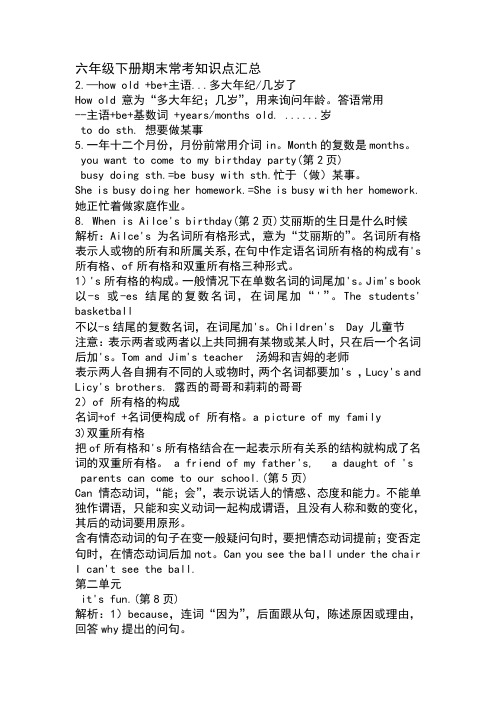
六年级下册期末常考知识点汇总2.—how old +be+主语...多大年纪/几岁了How old 意为“多大年纪;几岁”,用来询问年龄。
答语常用--主语+be+基数词 +years/months old. ......岁to do sth. 想要做某事5.一年十二个月份,月份前常用介词in。
Month的复数是months。
you want to come to my birthday party(第2页)busy doing sth.=be busy with sth.忙于(做)某事。
She is busy doing her homework.=She is busy with her homework.她正忙着做家庭作业。
8. When is Ailce's birthday(第2页)艾丽斯的生日是什么时候解析:Ailce's为名词所有格形式,意为“艾丽斯的”。
名词所有格表示人或物的所有和所属关系,在句中作定语名词所有格的构成有's 所有格、of所有格和双重所有格三种形式。
1)'s所有格的构成。
一般情况下在单数名词的词尾加's。
Jim's book 以-s 或-es结尾的复数名词,在词尾加“'”。
The students' basketball不以-s结尾的复数名词,在词尾加's。
Children's Day 儿童节注意:表示两者或两者以上共同拥有某物或某人时,只在后一个名词后加's。
Tom and Jim's teacher 汤姆和吉姆的老师表示两人各自拥有不同的人或物时,两个名词都要加's ,Lucy's and Licy's brothers. 露西的哥哥和莉莉的哥哥2)of 所有格的构成名词+of +名词便构成of 所有格。
a picture of my family3)双重所有格把of所有格和's所有格结合在一起表示所有关系的结构就构成了名词的双重所有格。
鲁教版五四制六年级英语下册知识点汇总
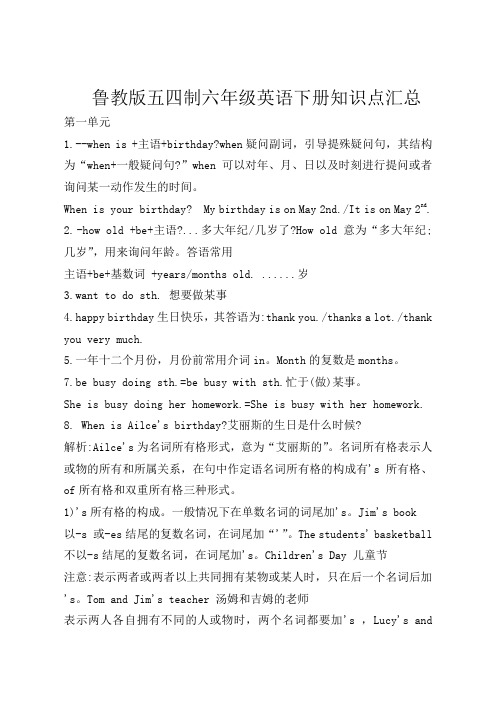
鲁教版五四制六年级英语下册知识点汇总第一单元1.--when is +主语+birthday?when疑问副词,引导提殊疑问句,其结构为“when+一般疑问句?”when可以对年、月、日以及时刻进行提问或者询问某一动作发生的时间。
When is your birthday? My birthday is on May 2nd./It is on May 2nd.2.-how old +be+主语?...多大年纪/几岁了?How old 意为“多大年纪;几岁”,用来询问年龄。
答语常用主语+be+基数词 +years/months old. ......岁3.want to do sth. 想要做某事4.happy birthday生日快乐,其答语为:thank you./thanks a lot./thank you very much.5.一年十二个月份,月份前常用介词in。
Month的复数是months。
7.be busy doing sth.=be busy with sth.忙于(做)某事。
She is busy doing her homework.=She is busy with her homework.8. When is Ailce's birthday?艾丽斯的生日是什么时候?解析:Ailce's为名词所有格形式,意为“艾丽斯的”。
名词所有格表示人或物的所有和所属关系,在句中作定语名词所有格的构成有's所有格、of所有格和双重所有格三种形式。
1)'s所有格的构成。
一般情况下在单数名词的词尾加's。
Jim's book以-s 或-es结尾的复数名词,在词尾加“'”。
The students' basketball 不以-s结尾的复数名词,在词尾加's。
Children's Day 儿童节注意:表示两者或两者以上共同拥有某物或某人时,只在后一个名词后加's。
